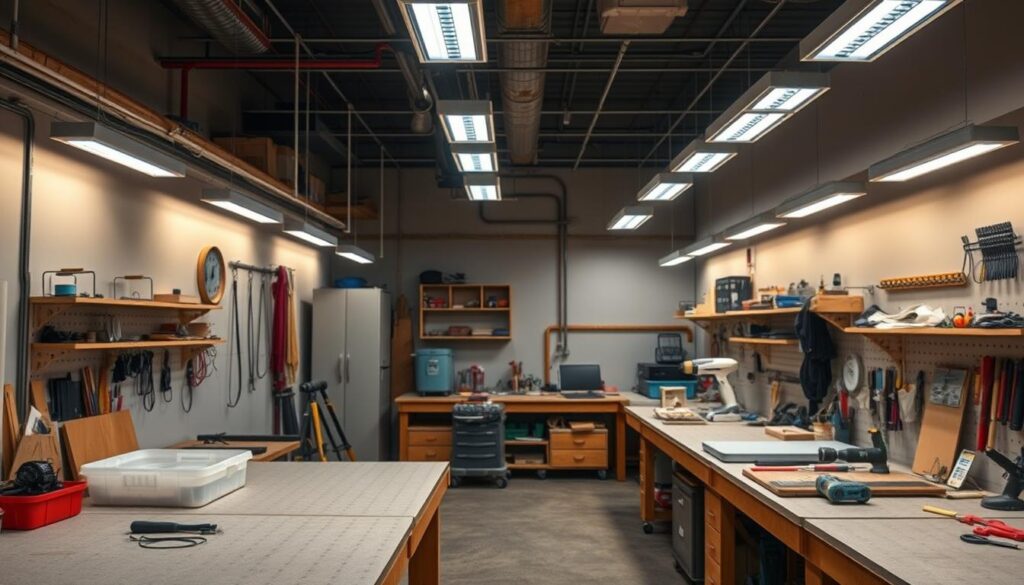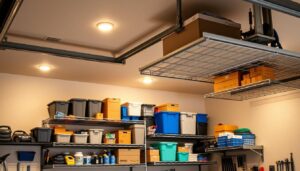Are you maximising your workshop’s potential with the right lighting? Proper illumination is crucial for productivity, precision, and safety in any workspace.
A well-designed LED lighting setup can reduce eye strain, prevent accidents, and enable more accurate work on detailed projects. Modern LED technology offers energy-efficient options that provide better illumination while reducing long-term operational costs.
Selecting the right lighting for your workshop is essential, whether you have a small home workshop or a large industrial space. In this comprehensive guide, we’ll explore how to choose the most suitable lighting solutions for your specific needs.
Key Takeaways
- Understand the importance of proper workshop lighting for productivity and safety.
- Discover how LED lighting can enhance your workshop environment.
- Learn how to select the most appropriate lighting solutions for your workshop activities.
- Find out how to reduce eye strain and prevent accidents with effective lighting.
- Explore the benefits of modern LED technology for energy efficiency.
The Impact of Proper Lighting on Workshop Productivity
Effective lighting solutions are essential for maximising workshop productivity. Proper lighting not only enhances visibility but also reduces eye strain and fatigue, leading to a more efficient working environment. “Good lighting is not just a matter of comfort, it’s a critical factor in precision and safety,” as industry experts often emphasise.
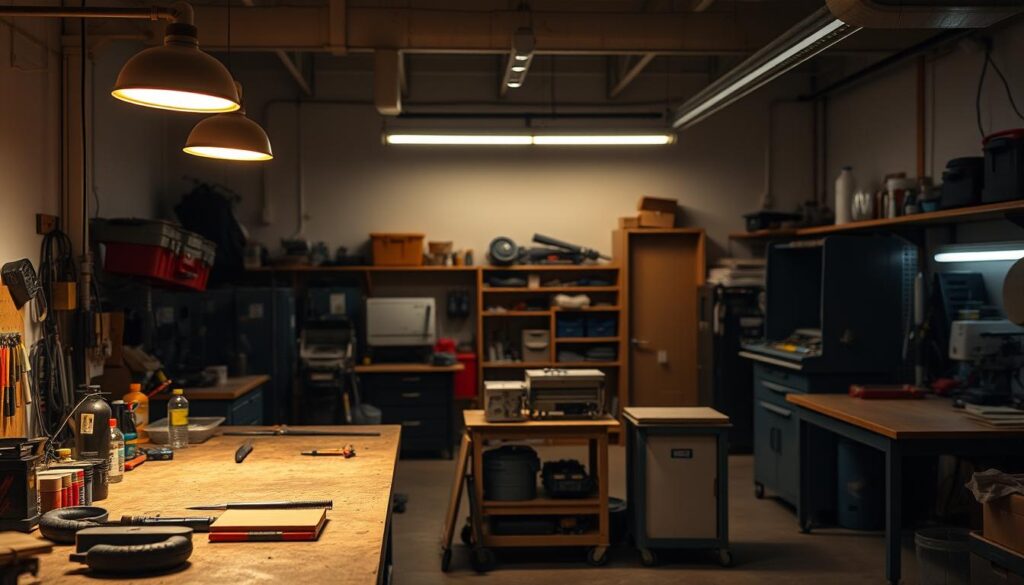
Understanding Lux Levels for Different Workshop Activities
Different tasks require varying levels of lighting. According to industry standards, rough assembly requires 300 lux, while precision assembly demands 1000 lux, and testing areas need 1500 lux with a colour rendering index (Ra) >80. Ensuring the right lux level for your tasks is crucial for optimal performance.
How Poor Lighting Affects Precision and Safety
Inadequate lighting can lead to a range of issues, including eye strain, headaches, and increased risk of accidents. Shadows and glare can obscure details, causing measurement errors in precision work. The price of accidents due to poor visibility can far exceed the cost of upgrading to proper workshop lighting. Maintaining adequate stock of replacement bulbs or fixtures ensures continuous optimal lighting without disrupting your workflow.
Essential Types of Lighting Solutions for Your Workshop
Effective workshop lighting is essential for both productivity and safety, and there are several types to consider. You have various options to illuminate your workspace effectively.
LED Batten Lights
LED batten lights are a popular choice for workshops due to their energy efficiency and durability. They provide a high level of illumination and are suitable for various workshop tasks.
Bulkhead Lighting Options
Bulkhead lighting is another viable option, known for its robustness and resistance to environmental factors. These lights are often used in areas where durability is crucial.
High Bay Lights for Larger Workshops
High bay lights are specifically designed for workshops with high ceilings, typically above 6 meters. They feature precision optics to maximise useful light and minimise lifetime costs, making them a worthwhile investment for larger workshops.
- High bay LED lights provide focused, powerful illumination from above.
- They deliver high lumen output (typically 15,000-30,000 lumens) to effectively illuminate large spaces.
- The price ranges from £100-£300, depending on output and features.
- Stock availability should be verified due to potential longer lead times.
Key Features to Consider When Choosing Workshop Lighting
Effective workshop lighting is not just about brightness; it’s about choosing the right features for your needs. When you’re deciding on the best lighting solutions, there are several factors to consider to ensure you get the right fit for your workshop.
IP Ratings Explained
The IP (Ingress Protection) rating is crucial as it indicates the level of protection a lighting fixture has against solid objects and water. For workshops, a higher IP rating is often necessary to withstand the environment. Look for fixtures with an appropriate IP rating to ensure durability.
Colour Temperature and Its Effects
Colour temperature, measured in Kelvin (K), affects the ambiance and functionality of your workshop. Different tasks require different colour temperatures; for instance, cooler temperatures (around 5000K) are often preferred for tasks requiring attention to detail. Consider the type of work you’ll be doing when selecting the colour temperature.
Wattage and Brightness Requirements
Wattage indicates power consumption, not brightness. Modern LED lighting produces more lumens per watt than traditional sources. For general workshop areas, 3000-5000 lumens are typically sufficient, while detailed work areas may require 5000-10000 lumens. The price of fixtures increases with brightness, but so does visibility.
| Workshop Area | Lumens Required | Wattage (LED) |
|---|---|---|
| General Workshop | 3000-5000 | 10W-20W |
| Detailed Work Areas | 5000-10000 | 20W-40W |
When checking the stock of specific wattage options, it’s essential to consider the availability of higher-output fixtures, as they may vary. Energy-efficient LED lighting, despite potentially higher initial prices, reduces long-term operating costs. 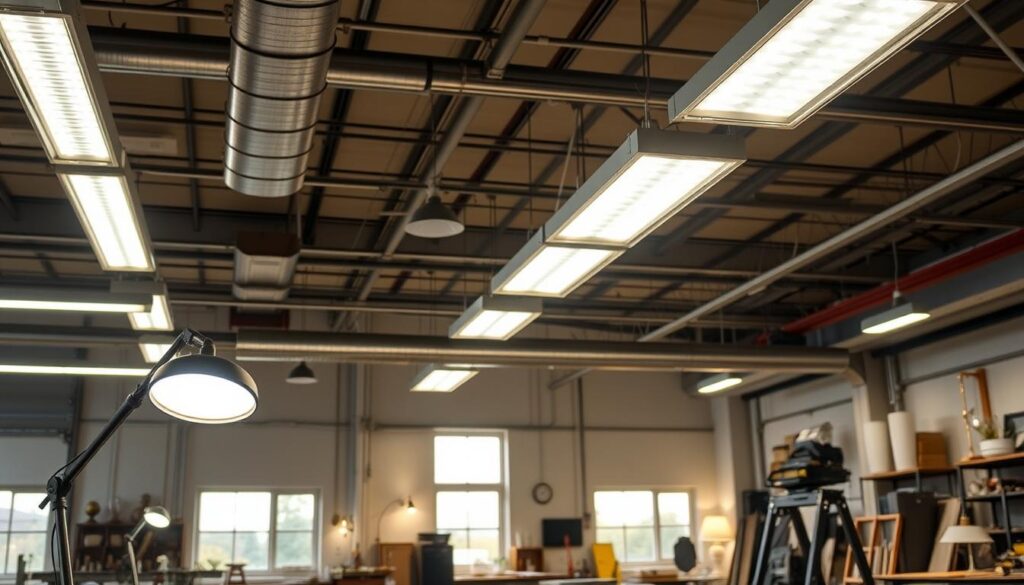
Top LED Workshop Lighting Products in the UK
In the UK, top LED workshop lighting products are designed to provide efficient and effective illumination. Here are some of the best options available:
VALA LED Batten Lights
VALA LED Batten Lights offer high-quality illumination with their advanced LED technology, providing a reliable LED solution for your workshop.
BALHAM Bulkhead Light Fittings
BALHAM Bulkhead Light Fittings are designed for durability and energy efficiency, making them a great choice for workshop lighting, with a competitive price.
High-Performance Linear Workshop Lights
High-Performance Linear Workshop Lights feature precision optics and high efficacy, meeting ISO standards. Although they may have a higher price, their performance justifies the cost, and they are available in stock for immediate purchase.
Smart Lighting Controls to Maximise Efficiency
To maximise efficiency in your workshop, consider integrating smart lighting controls. These systems offer numerous benefits, including energy efficiency, cost savings, and improved operational efficiency.
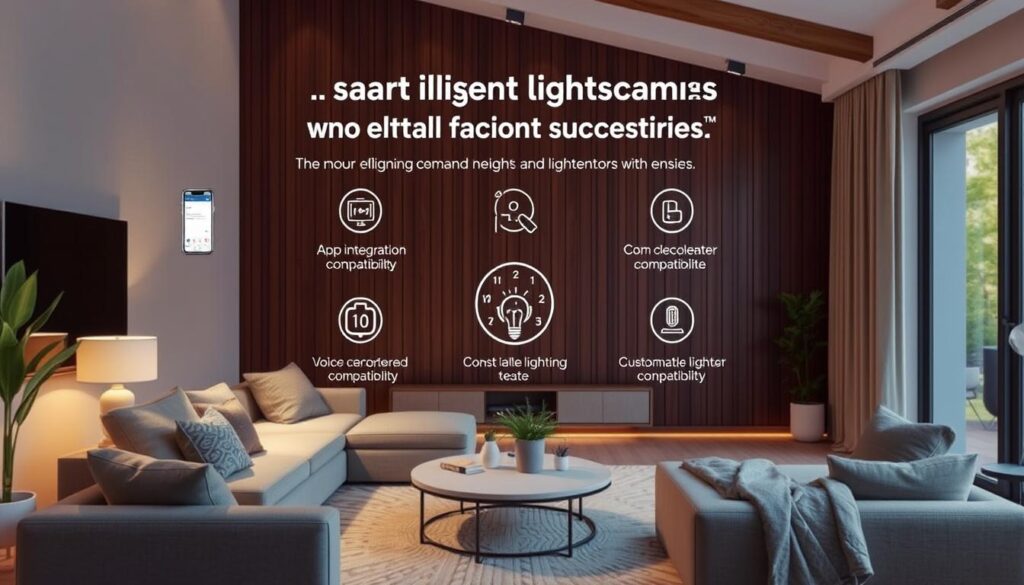
Motion Sensors and Occupancy Detection
Motion sensors and occupancy detection systems ensure that lights are only on when needed, reducing unnecessary energy consumption.
Daylight Harvesting Systems
Daylight harvesting systems adjust lighting levels based on natural light availability, further optimising energy use.
Wireless Lighting Control Benefits
Wireless lighting controls offer several advantages, including reduced installation costs and complexity. They also allow for flexible reconfiguration as your workshop layout changes.
The benefits of wireless lighting controls include:
- Eliminating complex control wiring, reducing installation costs and complexity.
- Allowing for flexible reconfiguration without expensive rewiring.
- The price of wireless control systems has decreased, making them more accessible.
- Good stock availability of wireless components, though compatibility should be verified.
- Many systems offer smartphone or tablet control interfaces for easier management.
For more information on optimising your workshop’s lighting with LED solutions, visit our guide on optimising lighting control systems.
Installation Considerations for Workshop Lighting
To get the most out of your workshop lighting, careful planning and installation are essential. This involves considering several key factors to ensure that your lighting system operates efficiently and effectively.
Optimal Positioning for Task Areas
Proper positioning of light fixtures is crucial for task areas. You should position lights to minimize shadows and glare, ensuring that work areas are well-illuminated.
Wiring and Power Requirements
Workshop lighting systems may require dedicated circuits to handle the combined load of multiple high-output fixtures. It’s essential to verify the stock of appropriate electrical components before beginning installation. Additionally, consider the power factor to avoid increased electricity costs. While LED lighting reduces power requirements, proper circuit planning remains essential. The price of proper electrical installation components is a small but crucial part of the overall lighting system budget. For more information on LED workshop lighting, visit https://www.meteorelectrical.com/blog/led-workshop-lighting.html.
Conclusion: Illuminating Your Path to Workshop Productivity
A well-lit workshop is essential for achieving optimal productivity and accuracy in your work. By investing in quality LED lighting, you can create a highly productive environment where precision work can be performed comfortably and safely. The wide range of lighting options available today means there’s an ideal solution for workshops of all sizes. Modern LED technology offers power efficiency and customised lighting environments tailored to specific activities, enhancing both productivity and safety.
